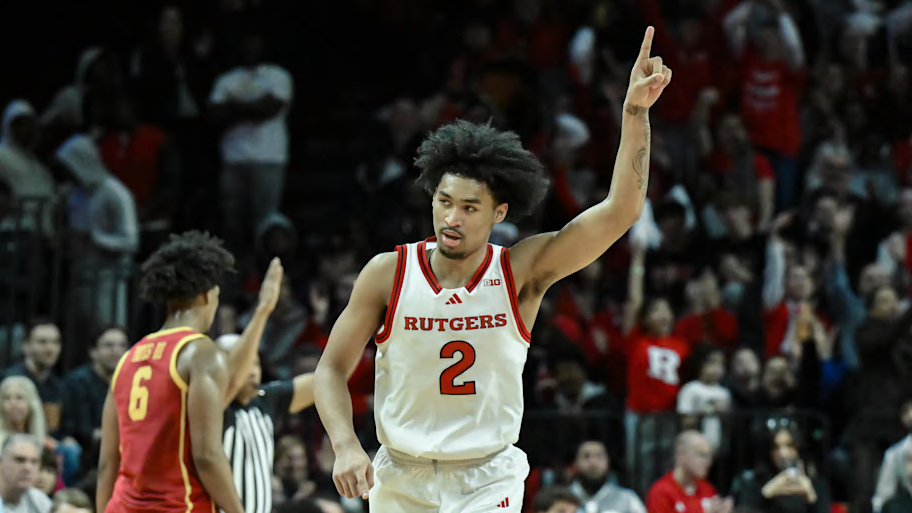The 2025 NBA draft is less than a month away, and one of the most fascinating developing storylines is this draft’s loaded point guard hierarchy. Several teams in the lottery and beyond could target a primary ballhandler of the future, and there could be multiple that go off the board in the first five picks. Which point guards are the cream of the crop in this year’s class? Sports Illustrated broke down the top options whose names you can expect to hear called in the first round on June 25.
Tier 1: Future Star
Dylan Harper, Rutgers Scarlet Knights
Harper’s the only player other than Cooper Flagg in this draft class that I believe has the potential to carry an offense on a winning team. Prospects with his combination of size, floor vision, handle and three-level scoring ability simply don’t come around often. At his best, there’s no ball-screen coverage capable of containing Harper’s scoring exploits. He’s relentless pressuring the rim thanks to his strength going downhill while being enough of a threat as a three-point shooter to keep teams out of conservative coverages that dare him to shoot over the defense. His 37-point outburst against Alabama remains among the most impressive single-game showings by any prospect this cycle and will stick with the dozens of NBA personnel who attended that game in Las Vegas in November. His ceiling probably resembles something comparable to what Cade Cunningham has blossomed into with the Detroit Pistons. It’s hard to envision him not returning close to starter-level value if nothing else because of his scoring exploits.
Tier 2: Plus Starters
Jeremiah Fears, Oklahoma Sooners
Fears being a potential top-five pick in this draft is remarkable when you consider he was playing AAU basketball with no plans to enroll in college until summer 2025 at this time last year. His late decision to reclassify and head to Oklahoma worked out immaculately for the 18-year-old point guard. It was impressive watching Fears take lumps early in the grind of SEC play and then bouncing back with a strong finish, one that helped the Sooners get to the NCAA tournament for the first time under Porter Moser. Fears scored 20-plus points seven times from Feb. 1 on, an explosive run against the best competition in the country that won over most remaining skeptics. The primary question for Fears in becoming a star is whether he’ll develop into a consistent shooter. He shot just 28% from deep at OU and an even-worse 23% in SEC play.
Kasparas Jakucionis, Illinois Fighting Illini
At his best, Jakucionis was nothing short of brilliant in his lone college season, continuing his upward trajectory from strong showings in the Barcelona youth system into college basketball to make him a clear contender to be a top-10 pick. Jakucionis doesn’t profile as a star at the next level mostly due to his athletic limitations, but his playmaking and ability to shoot off the bounce gives him a strong pathway to being a highly valuable complementary piece in the mold of Austin Reaves. Tightening his handle and cleaning up turnovers will be vital for Jakucionis to get on the floor in high-leverage situations early in his career.
Tier 3: Is he a PG?
Egor Demin, BYU Cougars
How you view Demin’s ceiling is determined in part by what you think his best position is long-term. Undoubtedly one of the best passers in this class, the question with Demin is whether he has enough on-ball juice as a scorer and ballhandler to warrant full-time playmaking duties or if he’d be better served as a wing connector with passing chops. He struggled at times at BYU to consistently make shots and also had issues dealing with the physicality and speed of college matchups. It’d be hard to fully bet on Demin blossoming enough as a primary ballhandler, but it’s within the range of outcomes that should intrigue NBA teams in the mid to late lottery.
Tier 4: Rotation options with upside
Nolan Traoré, Saint Quentin (France)
Traoré’s uneven season in France has seen his stock slip from being a perceived contender with Harper to be first point guard off the board to fighting to stay in the lottery. In some ways that feels like an overreaction given Traoré’s dynamic playmaking ability and speed in the open floor, though scouts have wanted to see more consistency and toughness as well as better efficiency from the 19-year-old. The downside here is real given his somewhat limited frame and ups and downs as a shooter, but Traoré would be a worthwhile swing for the fences in the late lottery or teens. It’s hard to imagine him falling much further than that.
Walter Clayton Jr., Florida Gators
Clayton in many ways is the opposite of Traore, a lower-risk pick but one with a more limited ceiling as a four-year college guard who lacks elite measurables or physical tools. The one thing Clayton does at an elite level though is shoot the three, and he’s among the most dynamic shotmakers in this class overall. Particularly with the new CBA and the rising costs of keeping together a core, finding controllable and inexpensive role players like Clayton who can provide instant offense presents valuable opportunities for teams.
This article was originally published on www.si.com as NBA Draft Point Guard Tiers: Dylan Harper Ranks at Top of Class.
